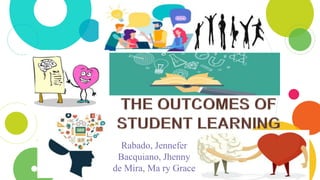
Learning Outcomes with Blooms Taxonomy
- 1. Rabado, Jennefer Bacquiano, Jhenny de Mira, Ma ry Grace
- 2. February 21, 1913 – September 13, 1999
- 3. ◎ Created on 1956 ◎ Collaborated with Max Englehart, Edward Furst, Walter Hill, and David Krathwohl. ◎ a set of three hierarchical models used to classify educational learning objectives into levels of complexity and specificity.
- 6. Three (3) types of learning outcomes: COGNITIVE • referring to acquired mental skills 6 PSYCHOMOTOR • referring to acquired manual or physical skills AFFECTIVE • referring to acquired growth in feeling or emotion ◎ https://www.slideshare.net/qbjbl720/the-outcomes-of- student-learning
- 7. COGNITIVE (knowledge) - referring to mental skills 1 7
- 8. The Original Taxonomy The Revised Taxonomy)
- 10. In the revised taxonomy, knowledge is at the basis of these six cognitive processes • Knowledge of terminology • Knowledge of specific details and elements Factual Knowledge • Knowledge of classifications and categories • Knowledge of principles and generalizations • Knowledge of theories, models, and structures Conceptual Knowledge • Knowledge of subject-specific skills and algorithms • Knowledge of subject-specific techniques and methods • Knowledge of criteria for determining when to use appropriate procedures Procedural Knowledge • Strategic Knowledge • Knowledge about cognitive tasks, including appropriate contextual and conditional knowledge • Self-knowledge Metacognitive Knowledge https://cft.vanderbilt.edu/guides-sub-pages/blooms- taxonomy/
- 13. PSYCHOMOTOR DOMAIN (skills) - referring to manual or physical skills 2 13
- 14. What is a Psychomotor Domain Objectives? ◎ It discreet physical functions, reflex actions and interpretative movements ◎ These types of objectives are concerned with the physically encoding of information, with movement and/or with activities where the gross and fine muscles are used for expressing or interpreting information or concepts ◎ Refers to natural, autonomic responses or reflexes 14
- 15. ◎Are concerned with how a student controls or moves his body ◎Emphasize some muscular or motor skill such as use of precision instruments or tools or athletic performance ◎Include examples of like typing 25 words per minute, printing letters correctly, painting a picture, or dribbling a basketball 15
- 16. LEVELS OF PSYCHOMOTOR DOMAIN 16
- 17. 17
- 18. LEVELS OF PSYCHOMOTOR DOMAIN ◎ Perception • The ability to use sensory cues to guide motor activity. This ranges from sensory stimulation, through cue selection, to translation Examples: 18 Color Listen Note Describe Look Observe Find Measure Record
- 19. ◎ Set • Readiness to act. It includes mental, physical, and emotional sets. These three sets are dispositions that predetermine a person's response to different situations(sometimes called mindsets) Examples: 19 Assemble Demonstrate Imitate Construct Execute Manipulate Copy Handle Perform
- 20. ◎ Guided Response • The early stages in learning a complex skill that includes imitation and trial and error. Adequacy of performance is achieved by practicing Examples: 20 Assemble Experiment Measure Connect Handle Relate Convert Manipulate Use
- 21. ◎ Mechanism • This is the intermediate stage in learning a complex skill. Learned responses have become habitual and the movements can be performed with some confidence and proficiency Examples: 21 Devise Manipulate Spell Out Execute Operate Use Install Perform
- 22. ◎ Complex Overt Response • The skillful performance of motor acts that involve complex movement patterns.Proficiency is indicated by a quick, accurate, and highly coordinated performance, requiring a minimum of energy • This category includes performing without hesitation, and automatic performance. For example, players are often utter sounds of satisfaction or expletives as soon as they hit a tennis ball or throw a football, because they can tell by the feel of the act what the result will produce Examples: 22 Assemble Convert Measure Conduct Label Use Connect Match
- 23. ◎ Adaptation • Skills are well developed and the individual can modify movement patterns to fit special requirement Examples: 23 Alter Move Shift Change Refine Shove Modify Revise Sift
- 24. ◎ Origination • Creating new movement patterns to fit a particular situation or specific problem. Learning outcomes emphasize creativity based upon highly developed skills Examples: 24 Create Recite and Count Remember and Apply Discard and Substitute Recall and Use Repair and Use Recycle and Use Select and Discard Recapitulate
- 25. AFFECTIVE DOMAIN (attitude) - deal with situations emotionally such as feeling, appreciation, enthusiasm, motivation, values and attitude 3 25
- 26. 26 CHARACTERIZING Internalize and beliefs in the value ORGANIZING Accepts different viewpoints, compare and relates with other values VALUING Attaches importance / worth to the information gained RESPONDING Inquiry, Response (Active Mode) RECEIVING Listen, Read (Passive Mode) LEVELS OF AFFECTIVE DOMAIN BLOOM’S TAXONOMY
- 27. 27 CATEGORIES/LEV ELS OUTCOMES VERBS RECEIVING Select, point to, sit, choose, describe, follow, hold, identify, name, reply RESPONDING Answer, assist, comply, conform, discuss, greet, help, perform, practice, read, recite, report, tell, write VALUING Complete, demonstrate, differentiate, explain, follow, invite, join, justify, propose, report, share, study, perform ORGANIZING Arrange, combine, complete, adhere, alter, defend, explain, formulate, integrate, organize, relate, synthesize CHARACTERIZING Act, display, influence, listen, discriminate, modify
- 28. Why Use Bloom’s Taxonomy? The authors of the revised taxonomy suggest a multi- layered answer to this question, to which the author of this teaching guide has added some clarifying points: Objectives (learning goals) are important to establish in a pedagogical interchange so that teachers and students alike understand the purpose of that interchange. Organizing objectives helps to clarify objectives for themselves and for students. Having an organized set of objectives helps teachers to: “plan and deliver appropriate instruction”; “design valid assessment tasks and strategies”;and “ensure that instruction and assessment are aligned with the objectives.”
- 30. Thanks You! 30